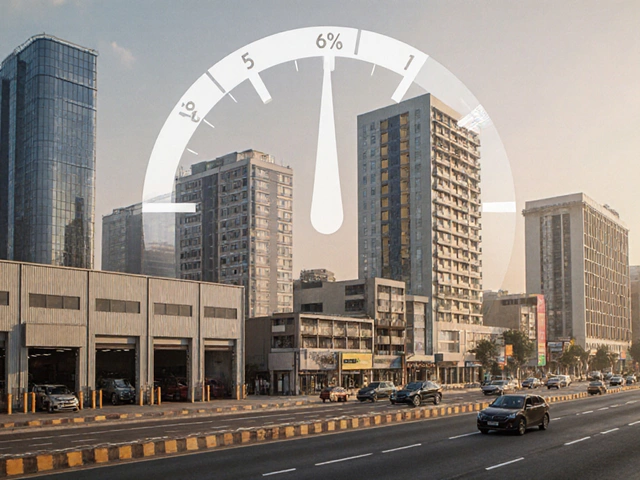Ever heard someone brag about an 8% cash-on-cash return like it’s the golden ticket for real estate investors? It sounds pretty impressive, but what does that number actually get you? If you’re sizing up a commercial property sale, you need to know exactly what cash-on-cash means—and when 8% is something to shout about or shrug off.
Here's the deal: cash-on-cash return is all about how much money you’re actually seeing back in your pocket from the cash you’ve put into a deal. No smoke and mirrors, just a simple percentage that shows the straight-up return on your upfront cash. But here’s a reality check—not all 8% returns are created equal, and not all properties are worth chasing even if that number looks solid on paper.
- What is Cash-on-Cash Return?
- How to Calculate It (and What 8% Really Means)
- How 8% Compares to Market Standards
- Key Tips to Evaluate Your Property Deal
- Pitfalls to Avoid When Chasing Return Numbers
What is Cash-on-Cash Return?
Cash-on-cash return is a simple but powerful way to figure out how hard your money is working in a commercial property investment. It tells you what percentage of your actual cash investment you’re getting back every year from rental income after covering expenses–kind of like asking, "How much do I really make versus what I spent upfront?"
It’s different from other metrics, like cap rate, because it doesn’t care about the total value of the property or loans you took. It just looks at how much cash you put in and how much cash you’re getting out each year. Let’s say you bought an office building for $1,000,000. If you put down $250,000 of your own cash and financed the rest, your cash-on-cash calculation ignores bank loans and focuses on that $250,000 you invested yourself.
Here’s the formula, plain and simple:
- Cash-on-cash return = (Annual pre-tax cash flow ÷ Total cash invested) x 100%
For example, if you make $20,000 a year in net income (that’s after you pay the mortgage, property taxes, insurance, and other costs) on your $250,000 cash investment, your cash-on-cash return is (20,000 ÷ 250,000) x 100%, so 8%.
| Property Price | Cash Invested | Annual Net Cash Flow | Cash-on-Cash Return |
|---|---|---|---|
| $1,000,000 | $250,000 | $20,000 | 8% |
| $500,000 | $100,000 | $8,000 | 8% |
If your cash-on-cash return is high, your money is working hard. If it’s low, it’s sitting idle—or you could find something better. And remember, lenders and experienced investors talk about this number a lot. It's a quick gut-check before digging deeper into a property’s features or location. Among all the real estate buzzwords, cash-on-cash return is one metric you can’t skip if you really want to know what you’re earning.
How to Calculate It (and What 8% Really Means)
So let’s cut through the confusion—calculating cash-on-cash return is dead simple, and knowing how it works can make or break your deal. First, you only need two numbers: the annual pre-tax cash flow from the property and the actual cash you’ve poured into the investment. Forget mortgage balance or the full property price; focus on what you’ve paid out-of-pocket—usually the down payment, plus closing costs and immediate repairs.
Here’s the formula that every investor should memorize:
- Cash-on-Cash Return = (Annual Pre-Tax Cash Flow ÷ Total Cash Invested) × 100%
Let’s walk through a real-world, no-nonsense example. Say you shelled out $200,000 in total for the down payment, fees, and upfront repairs. After rent checks come in and you pay out all the annual expenses, you pocket $16,000 before taxes. Plug it into the formula:
- $16,000 (Annual Pre-Tax Cash Flow) ÷ $200,000 (Cash Invested) × 100% = 8%
That 8% means that for every dollar you invested in actual cash, you got back eight cents over the year. Here’s a quick table showing a few different scenarios to make things even clearer:
| Total Cash Invested | Annual Pre-Tax Cash Flow | Cash-on-Cash Return |
|---|---|---|
| $150,000 | $10,500 | 7% |
| $200,000 | $16,000 | 8% |
| $250,000 | $22,500 | 9% |
Stick with this calculation, and you can compare deals apples-to-apples, or benchmark your return against other investments. But keep in mind—an 8% return on a small cash investment feels a whole lot less powerful than 8% on a big pile of cash. Always factor in the scale of your investment and the risks you’re taking on, especially in commercial property. The bottom line: the number’s easy to get, but the meaning shifts depending on your unique situation.

How 8% Compares to Market Standards
So, is 8% a solid cash-on-cash return in today’s commercial property world? It depends where you’re looking and what kind of property is on the table. But here’s some straight talk: over the past couple years, average cash-on-cash returns for commercial properties in the U.S. have hovered between 6% and 8%, according to CBRE’s industry reports and surveys from trusted investment sources.
If you’re buying in a big metro area—think downtown Chicago, New York, or San Francisco—the numbers can slide a bit lower, sometimes in the 4%-6% range. These markets are crowded, prices are high, but demand is steady, so investors will accept less immediate return for more perceived stability.
On the flip side, secondary or smaller cities can see deals topping 8% pretty often. But these markets usually bring a bit more risk—maybe slower tenant demand or more economic ups and downs. Here’s a quick snapshot to see where 8% sits:
| Market/Asset Type | Average Cash-on-Cash Return (2024-2025) |
|---|---|
| Primary Markets (big cities) | 4% - 7% |
| Secondary Markets | 7% - 10% |
| Industrial Warehouses | 6% - 9% |
| Retail Properties | 5% - 8.5% |
| Multifamily (Apartments) | 5.5% - 8% |
That means an 8% cash-on-cash return lands you on the higher side for most commercial investments right now, especially if you’re in a safe location or with a decent quality building.
Keep one thing in mind: commercial property sale prices often move faster than rents, which impacts return calculations. Economic cycles, interest rates, and loan terms all play a part too. Compare any return you’re offered not just to the averages, but to what makes sense for your personal risk tolerance and bigger financial goals.
Key Tips to Evaluate Your Property Deal
If you’re eyeing an 8% cash-on-cash return on a property, don’t just stop there. Not all deals are created equal, even if the number looks great upfront. Here’s how to really size up if your investment stacks up in the real world.
- Look beyond the return number. Ask, “How steady is this income?” If your property’s main tenant is a trendy restaurant that’s only been around for a year, that 8% can turn into zero real fast if the place shuts down. Check the lease lengths, tenant track records, and any early termination clauses.
- Check market rents. Compare what your tenants pay to what similar spaces are getting nearby. If your building’s rent is way above the local average, you could face problems keeping tenants when leases expire. Sites like LoopNet or CREXI can give you current market rent data.
- Understand all expenses. Get picky about what’s included in expenses your seller lists. Has the seller skimped on repairs or left out common area maintenance? Don’t get burned. Ask for actual utility bills, maintenance contracts, and tax statements for at least the last two years.
- Plan for surprises. Budget for stuff landlords don’t talk about upfront, like roof repair, parking lot resealing, or new HVAC units. Set aside money in a capital reserve fund, so when the inevitable happens, your return doesn’t take a nosedive.
- Zoom out: Check trends for the area. Is the neighborhood growing, or are businesses closing shop? More people and new developments usually mean rising rents and property values. Flat or declining populations could signal future trouble, even if your calculator says 8% today.
Stack all this info against what you’re paying—even small changes in rent or expenses can swing that 8% for better or worse. Don’t just trust the pitch. Dig into the real numbers, and make sure that return holds up in the long run.

Pitfalls to Avoid When Chasing Return Numbers
Let's get real: some investors get a bit obsessed with cash-on-cash return and forget the bigger picture. Chasing a shiny number like 8% can lead to some expensive mistakes if you’re not careful. Commercial properties aren’t just spreadsheet math; there’s a lot going on behind the scenes that can mess with your returns.
One big trap is ignoring risk. A higher cash-on-cash return often means there’s more risk baked in. For example, a property in a struggling neighborhood or with high turnover might flash big returns—on paper. But what happens when your tenants bail or you face months of vacancy? According to the National Association of Realtors, office vacancy rates nationwide hung around 16.7% in 2024. If you don’t account for those empty months, your actual return drops fast.
Don’t trust numbers that don’t add up. Sometimes, sellers pump up their property’s returns by leaving out big-ticket expenses like repairs, management fees, or even property taxes. Always double-check what’s getting left out—and ask for backup documents, not just rounded estimates.
- Watch out for one-time rental spikes, like a short-term lease to a high-paying tenant. Once they’re gone, your returns could nosedive.
- Don’t forget about capital expenses. Roofs, HVAC systems, parking lots—they don’t last forever, and they’re not cheap to fix.
- Avoid over-leveraging; borrowing too much to chase higher returns can leave you in a pinch if rates go up or rents go down.
Here’s a quick breakdown of what to double-check before trusting a return number:
| What to Review | Why It Matters |
|---|---|
| Vacancy Rate | Impacts cash-on-cash return directly if empty months aren’t included |
| Operating Expenses | Missing expenses can bump ROI up artificially |
| Market Trends | If rents are falling, future returns won’t match current numbers |
| Tenant Stability | Unstable tenants mean unpredictable income |
| Debt Service | Major loans bring risk if interest rates climb or income drops |
Here’s the bottom line: an 8% return might sound great, but if you don’t dig into the details, that number could vanish in real life. Stick to properties that make sense long-term, not just on paper, and always stress-test your numbers against worst-case scenarios.







Write a comment